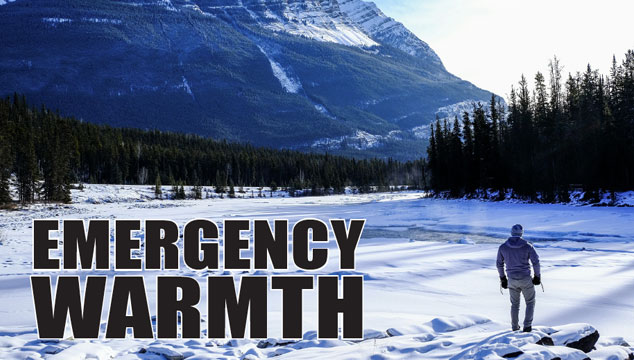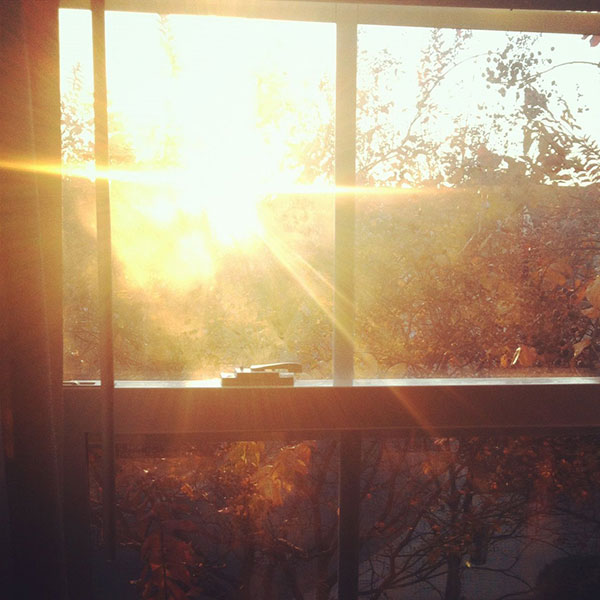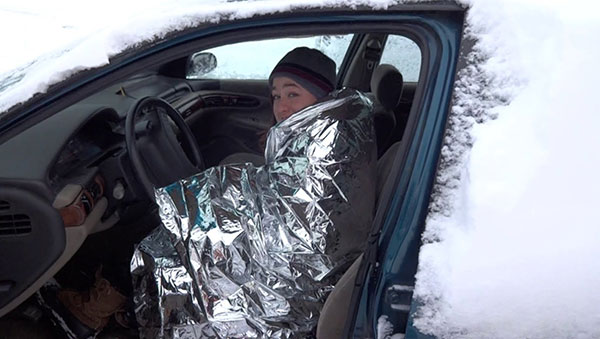
Roughly 1,000 people die each year in the U.S. from hypothermia according to the CDC. Most of the people that die from hypothermia are the elderly and the homeless. These unfortunate souls perish in their unheated homes or in the outdoors. Plus there are often extenuating circumstances in these deaths. Namely, major health issues and alcohol consumption.
But consider what the numbers would be like if our country faced a major crisis in the winter? A grid failure or cyberattack coupled with the cold could kill many thousands more. That’s why strategies for emergency warmth should be a high priority for your family, wherever you live.
Tricks For Warmth In Any Situation
Regardless of your scenario, these are some simple tricks that can keep you much warmer when the weather turns cold:
- Pick The Right Fabrics. Dress for success when you’re dealing with the cold. Synthetic fabrics and wool are your best choices as these materials offer insulation even when wet. You can also add insulation to insufficient clothing, as we will discuss later.
- Dress In Layers. Nothing beats layered clothing for giving you the ability to thermoregulate. Add or subtract layers as needed to avoid sweating while you work or to warm up while sitting still. Make sure you bring the right clothing selection before heading outdoors.
- Eat and Drink. Staying properly hydrated is vital to staying warm and eating extra calories needs to be part of your plan. Nothing steals the calories from your body like the cold, so eat extra food to replace what you lost. You may even need to wake up in the night and eat a little something to stay warm.
- Bring Hand Warmers. Plan ahead by bringing hand warmers or the larger foot warmers. These can go inside your clothing as a temporary heat supplement and they can even prevent mild hypothermia.
- Use Hot Water Bottles and Rocks. Find a few rocks in the snow and use a fire to warm them up a little bit. Then place them in your coat or bedding as heaters. You can create a hot water bottle if rocks are in short supply. Do this by pouring hot water into a water bottle, sealing it tightly, and then slide it down into a thick sock. This portable heater can stay warm for over 6 hours and provides a great supplementary heat for your bed or while walking around.Turn rocks and bricks into a space heater if you need to heat a whole room. Get some rocks or a few bricks from a dry location. Next you can fire up the grill or build a fire outside. Throw the rocks or bricks in the fire to heat them up for about 45 minutes or until red hot. Handle cautiously and scoop them out with a shovel. Get all the coals and sparks off of the bricks or rocks. Drop them into a stainless steel cooking pot but don’t use a galvanized container as it will release toxic fumes. Carefully bring the pot of hot rocks or bricks inside and set it on a fireproof platform like a layer of bricks.
Don’t Freeze In A Building
Whether at home, work, or some random site where you’ve taken shelter, there are many ways to have emergency warmth. If you’re at a home with a working fireplace or woodstove, this is a great way to fight the cold weather as long as the woodpile holds out. These days most people don’t have a stove or functional fireplace. As mentioned earlier, you can heat a room with a pot full of hot stones or bricks. This can save those who rely on electric heat or a system that needs electricity to burn fuel. Here are four other important things to consider.
Don’t Heat The Whole Building. In a home or building, forget about heating the whole thing. You’ll never be able to make every room warm and comfortable again. It’s a waste of time and a waste of resources. Just pick one room, preferably a smaller room with a low ceiling, to be your main living area during the emergency.
Make Heat From The Sun. Passive solar heat can be a great source of warmth during daylight hours and in sunny conditions. Consider a room with south facing windows for your emergency quarters. Open the blinds then lay out dark colored blankets and rugs on the floor to absorb the heat from the sun.

Place other dark objects, like the useless TV, in the path of the sun as another heat absorber. There’s a reason your pet lays in a sunny window in the winter, they can feel the heat. The more windows and dark colored objects you place in the light, the more heat you will feel too.
Never Use Combustion Without Ventilation. This makes the news every year…Some jackass fires up a propane heater or a BBQ grill inside their home during a power outage. You’re just begging for carbon monoxide poisoning if you do this. Even a kerosene heater made for indoor use needs to have some fresh air. Make sure you have a working smoke alarm with a carbon monoxide detector if using a combustion based heat source.
Build Your Own Bedding. One trick that helps with warmth during a power outage is to act like you’re camping. Break out the tent and set it up over a large mattress. Then roll out the zero degree sleeping bags and lay around inside them. The tent helps to retain a little body heat and the sleeping bag holds in the rest. If you lack these materials, put together an urban survival sleeping bag and mattress from common materials.
Create a makeshift sleeping bag from a very large trash bag. Fill the bag with crumpled paper, bubble wrap, packing peanuts, styrofoam, or any other lightweight materials that are full of airspace. Stacking up many layers of cardboard will create a warm mattress on the bare floor or concrete. Crawl inside the bag and try to get some sleep. In the event that you’re too tall for your trash bag cocoon, cut the bottom out of one bag and duct tape it securely to a second bag. This will be long enough for even a very tall person.
Stay Warm In A Vehicle
When your survival situation involves a vehicle, it’s only natural to run the engine for warmth. This can save your life but only if you can keep the exhaust clear. Vehicle exhaust can back up into the cabin when the exhaust pipe is buried in snow, slush, mud, or water. This can lead to death from carbon monoxide poisoning. The vehicle can still keep us warm even don’t run it to save gas. The protection of the vehicle can be coupled with insulation or some kind of external heat source.

For insulation to work, you’ll need a lot of it. Winter sleeping bags are a great thing to carry in the vehicle. Regular blankets and space blankets are a cheaper choice. If none of those things are available, you can fill the vehicle cabin with material that can hold in warmth. As a final option, we can also use hot rocks. Pull back the carpeting to expose the metal floor while you heat up some stones in a fire outside of the vehicle. Don’t go to red hot for safety, just get them hot.
Use a shovel or a similar tool to move the rocks into the vehicle. Make sure that nothing flammable or capable of melting touches the stones. If you can move the vehicle a little, try parking so that the windshield faces south. On sunny days, you’ll experience the same heat gain as we discussed using a south facing room.
Heat Things Up In The Wild
If you find yourself stuck in one place in the winter wilderness, putting up a tent or building a survival shelter can get you out of the cold. But what if you need warmth that can travel with you? Try stuffing your clothes with debris. It can be almost anything as long as it holds dead air space. Use leaves, moss, grass, pine needles, ferns, or other vegetation.
You can also use man made materials for insulation. Foam, crumpled paper, cardboard, packing materials, and other supplies can be used. Fill your pants, sleeves, shirt, and hood. You’ll feel very ridiculous and a little uncomfortable, but also warmer!
